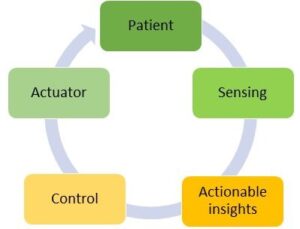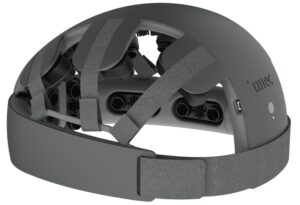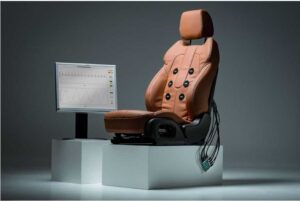
Views: 30
– Detection, performance and cure. If we could combine vital sign detection capabilities with intelligent algorithms and action capabilities to not only diagnose, but also “correct” a problem in the body?
Minapim by Hernan Valenzuela: Just like a pacemaker does today, several closed loop wearable and wearable electronics systems will help us in the future. The best-known example of an autonomous, closed-loop therapy device is a pacemaker. Second, although not yet commercially available, are smart insulin pumps.
With artificial intelligence and miniaturized sensors and actuators, the components are there to shape a future with a multitude of closed-loop systems for remote, preventive and curative health. Think of medical-grade wearable electronics that measure blood pressure and help you find the right dose of blood pressure-regulating medication.
Think of small implants that stimulate specific nerves based on migraine biomarkers detected in real time. Or think of invisibly integrated sensors in (car) seats and office chairs to monitor the lung capacity of lung patients and advise them on their fitness program.
Senior researcher Vojkan Mihajlović and Evelien Hermeling, principal scientist at Imec, share their views on how closed-loop systems, consisting of wearable, implantable, invisible electronics and intelligent algorithms, will transform health.

From pacemakers to anesthesia
Thousands of results on artificial pancreas appear on Google, according to Hermeling: “In fact, the evolution of diabetes treatment is ideal to illustrate what a closed-cycle therapy system is.
Patients switched from fingerprints and insulin pens to glucose monitors in their abdomen or arm that measure continuously and send alarms to their cell phones. “
“The most advanced systems today as Medtronic’s Minimized ™ 670G insulin pump, go one step further and add a small wearable computer to the continuous glucose monitor.

The computer captures the data, calculates the amount of insulin needed and sends that information to the insulin pump that is also connected to the patient’s abdomen. In this way, blood sugar remains stable day and night, automatically.
The artificial kidney for dialysis patients is another typical example, although it is still in the distant future. It is also predicted that, for other chronic or acute conditions, next-generation treatments will no longer be restricted to chemicals.
Soon, doctors will be able to prescribe drug treatments in combination with wearable and caring, closed-loop electronic devices that monitor the drug’s effect or suggest changes in its dosage (known as the titration process).
According to Mihajlović: “Also for doctors, closed circuit systems exist to make life easier. Think of a closed-loop system for anesthesia: the anesthesiologist sets a target blood pressure and the system automatically maintains that target when dosing the appropriate medication. This allows specialists to focus on the patient and frees them from repetitive and automated tasks. “
Preparing the future closed circuit therapy system

Systems of sensors and wireless actuators, reliable and with artificial intelligence for data interpretation, new systems more intelligent and more autonomous to keep an eye on the patient’s health. In Hermeling’s opinion: “A typical closed-loop system is made up of different parts, each with its specific requirements.
The sensor module measures one or more parameters of the patient’s body, such as heart rate, ECG, blood pressure, etc. The sensors must be accurate, small and capable of wirelessly transmitting your data to the cloud or a device in the vicinity of the patient. “
“Next, a small processing unit is needed, running algorithms that can interpret this sensor data into actionable insights. Personalization is key.
Contextual and environmental parameters need to be considered. Blood pressure lowering drugs, ideally titrated for one person for a normal day, can cause blood pressure to drop during hot weather. This can be a dangerous situation that needs to be corrected. Algorithms would be able to adjust the doses, taking into account such contextual and environmental parameters. “
“A third building block is the control algorithm, which translates the insights into a control action. For example, the accumulation of too much fluid in the body can result in increasing the dosage of the medication for a patient.
“And the last part is the actuator hardware, for example, the microbomb distributing a drug in the bloodstream, based on the instructions you received from the control algorithm. A small form factor and precise and timely operation are the most important features of this building block. “
Main building blocks of a closed circuit therapy system. Dark blues are usually hardware components, while white blocks are mainly software modules.
Closed circuit therapy systems can have many different factors: wearable, implantable, invisible, for Mihajlović, Invisibles are sensors that are perfectly integrated into the patient’s environment. Think of sensors on a (car) seat, a car dashboard, a mattress or even a toilet seat.
While wearable and implantable electronics measure continuously, invisible electronics measure only occasionally, which is sufficient for certain types of measurements. Daily check of blood pressure, urine composition or lung capacity. “

Imec is known for its electronic miniaturization work, which is researched in state-of-the-art clean rooms.
From 15 years ago, work began with detection systems for monitoring vital signs.
Collaborations with the industry, such as Samsung and Biotelemetry, came in a large study on stress monitoring in real life conditions and on different prototype devices to measure brain waves, eye movements, gait, sleep patterns, breathing, pain and stress , and general health parameters. “
“The focus has been on making very compact, low-power and wireless sensor systems, with efficient data acquisition, using different modalities, such as heart, lung, muscle or nerve activities and integrating them into different devices such as a clock , patch, headset. Imec works to expand the efficient acquisition portion, with intelligent algorithms to provide actionable insights and operating principles to close the cycle. “
It is necessary to develop algorithms for a good interpretation of the data collected from the sensor and to guarantee the quality of the reliable data in real life conditions and in uncontrolled environments. For Mihajlović, Imec acts in the field of performance and stimulation, exploring the possibilities of non-invasive brain stimulation and electrical stimulation of nerves with small implantable nodules.
A software structure is underway that facilitates the acquisition of multimodal data, signal interpretation and specification of control rules necessary for optimal performance. This structure connects all of these components in a true closed loop system, to meet time requirements and feedback / performance modalities.
Examples of work at Imec

- A headset that fights depression, migraines
- Small implantable nodules that stimulate your nerves
- Using the patient’s environment to monitor vital signs
The applications for tCS are numerous, ranging from treatment of depression and migraine to epilepsy and anxiety disorders. In a closed loop system, it is important to measure brain waves during and after stimulus application, so that stimuli can be adapted to facilitate personalized treatment.
“Traditionally, the method involved two large electrodes placed at different locations on the scalp with current going from one electrode to the other. The electrodes were made of conductive polymer wrapped in a spongy shell, soaked in saline.”
“The most recent approaches to tCS depend on a larger number of smaller electrodes (1 cm²). Imec developed EEG monitoring headsets with small dry electrodes, together with Datwyler. They are very easy to use and provide high quality measurements.

The dry electrodes are being adapted for tCS. For this application, we plan to extend the capabilities of the headset with digital active electrodes, with electrical and optical resources. This makes it possible to measure and stimulate simultaneously without interference. (for example, electrical stimulation, optical detection and vice versa).
Imec EEG headset research platform with optical and electrical modalities to measure and stimulate brain activity. Possible applications are in the treatment of depression, migraine, epilepsy.
Imec developed a phantom head to facilitate the exploration of safety aspects and the impact of tCS on the head tissue. In addition, it allows to optimize the monitoring and stimulation of the brain in a closed circuit. Wearable electronics.
Want to know more?
- Download our white paper on implantable.
- Learn more about Imec and the different ways to collaborate in the field of connected health solutions.
- Discuss your ideas with Zohaib Gulzar, business development manager : health@imec.be
Source: IMEC
Related article: Wearable electronics, how nanotechnology enables